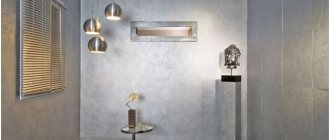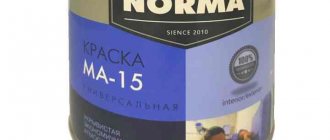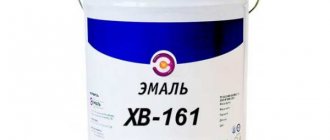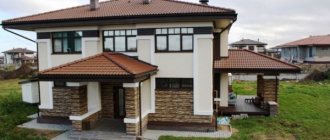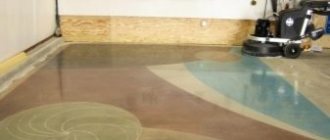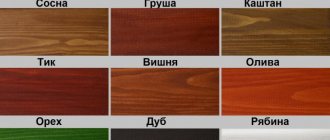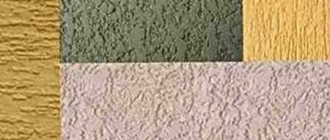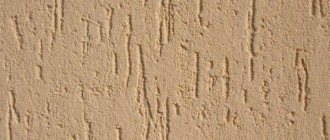CV paints for facades in their composition are a suspension of natural or synthetic pigments in perchlorovinyl resins.
These materials are used for outdoor work where protection from aggressive environmental influences (for example, precipitation) is required.
Perchlorovinyl paints (PV) have bright, saturated colors, they dry relatively quickly, and have excellent adhesion to concrete surfaces, which makes them widely used everywhere.
[contents]
Dyeing technology
Now all that remains is to familiarize yourself with the technology of painting façade polyvinyl chloride paint. The presence of aggressive volatile substances requires that you use personal respiratory and eye protection when painting.
- To apply the coating, the substrate must be clean and dry. Remove all lights, antennas, air conditioners and other equipment from the facade. We advise you to remove the trim from door and window openings.
- Clean the surface from dirt, debris and peeling.
- Fill cracks, crumbling or chipped areas with putty, and in case of large defects, apply a leveling layer of any (ideally cement) plaster.
- To apply the material, the weather must be dry, and it is undesirable that direct rays of the sun fall on the paint during the process, since in this case the layer will immediately dry out and quickly crack.
- Paint should be applied using a sprayer. You can do everything manually using a brush or roller.
Please note that if the work is carried out at sub-zero temperatures, the paint cannot be diluted with water, as in this case the coating will be damaged. https://www.youtube.com/embed/58gdouAlU1E
From all that has been said above, we can conclude that this type of paints and enamels has fully justified its popularity, despite the fact that it appeared on the construction market relatively recently. This topcoat is of high quality and optimized for use in temperate climates. Those disadvantages associated with the features of use are perfectly compensated by low cost and durability.
TOP 9 stores where I shop profitably
- Petrovich - construction-trading house
- InstrumTorg
- Leroy Merlin
- Stroylandia- Construction and finishing materials
- OBI - building materials and everything for the home
- Building yard
- Maxidom
- All Tools
- Garage Tools
TOP 7 for goods and furniture for the home:
- Brownie
- Furniture for home
- HomeX - everything for decoration
- Designer furniture
- Furniture and kitchens to order
- 220 Volt - Tools for home
- MVideo equipment for home
7 best construction and furniture stores!
Facade decoration performs two main functions - it decorates the house and protects it from external influences. Many different methods are used for cladding, one of which is painting.
If you are planning to choose this method of exterior finishing, then you should pay attention to perchlorovinyl paints for facade finishing. The material appeared relatively recently, is not known to everyone, so it deserves to get to know it better
Specifications
Like any other type of finishing material, this one has several varieties, which differ in the amount of volatile substances in their composition, as well as in their purpose and method of application. It must be said that the technical characteristics of perchlorovinyl paint vary depending on the specific variety.
Classification
So, the main types can be called the following:
Enamel XB-125. Used for painting exclusively wooden and metal surfaces;
Enamel can be sold in large metal containers
Perchlorvinyl facade paint HB 161. This is a mixture of various fillers and pigments that are dissolved in 10% PVC varnish. The share of non-volatile substances is about 47%. This type is used for painting brick buildings, as well as plastered surfaces;
The photo shows the paint XB 161
Enamel XB-182 is a modified enamel in which the proportion of non-volatile substances can be as low as 36%. Used for decorative painting of concrete and brick surfaces.
Another representative of perchlorovinyl enamels
Of the latter two, XB 161 is the most widely used, since its price is relatively low. In addition, XB 161 paint is almost universal in terms of temperature conditions - you can work with it in the temperature range from -20 to +40 degrees.
Characteristics of XB 161
Here are the main technical characteristics of perchlorovinyl facade paint XB 161:
- Complete drying time (ambient temperature is 20 degrees above zero) – no more than a day;
- Paint consumption per unit area is about 270 g with an average layer thickness of about 25 microns;
- Viscosity – 30-45 s. This value of this indicator allows you to use the spray gun without adding solvents or other thinners;
- The relative amount of non-volatile substances is no more than 47%;
- After hardening, the layer has bending elasticity - a maximum of 5 mm;
It must be said that the other two types have similar indicators, but still different from the data.
Applying material using a roller
Like any other material, this enamel has its positive and negative qualities.
The advantages include the following properties:
Very high degree of adhesion. This allows the paint to be absorbed deeply into the structure of the base, which creates a barrier against moisture. In addition, the paint itself is capable of maintaining its integrity for a very long time;
Advice! To further increase adhesion, before using this material, the surface is coated with a special perchlorovinyl primer.
- The presence of several types allows the use of similar enamels on all types of surfaces;
- The ability to perform coloring even at subzero temperatures (which applies to a greater extent to XB 161);
- Preservation of rich and deep color for at least 5 years. Such paints begin to “fade” only after 3 years, but even after 5 years they remain quite bright compared to conventional acrylic enamels.
All materials can be painted
Negative properties include the following:
- Inability to work in extreme heat or rain. Under no circumstances should such paints be mixed with water, and a large amount of ultraviolet radiation will cause the paint to crack before it has completely dried;
- Quite low elasticity, which requires the base to be even. Otherwise, cracks will appear.
Tip! To make the paint dry longer, which is especially important in the case of high ambient temperatures, you can add a soap solution to it. Indeed, by adding a little soap solution, you can ensure that the paint will dry for a longer period, which means it will not crack even at very high temperatures.
Indeed, by adding a little soap solution, you can ensure that the paint will dry for a longer period, which means it will not crack even at very high temperatures.
It must also be said that GOST for perchlorovinyl facade paints does not require the presence of such a solution, so it is impossible to say exactly how much it should be added - the more solution, the longer the paint will dry.
By the way, GOST for perchlorovinyl paint (only for XB 161) has the digital designation 25129-82.
HV-161 facade paint, frost-resistant, white
PURPOSE:
Paint ХВ-161 (enamel ХВ-161) is intended for painting concrete, brick, plastered surfaces of building facades, critical architectural structures and other structures operating in atmospheric conditions. XB-161 paint is a suspension of pigments and fillers in perchlorovinyl varnish.
PROPERTIES:
Paint ХВ-161 (enamel ХВ-161) has high weather resistance, oil and petrol resistance, and abrasion resistance. It has good vapor permeability, forming a “breathable” coating. Can be tinted in various shades. The service life of a two-layer coating in temperate climates is at least 3 years.
MODE OF APPLICATION:
SURFACE PREPARATION: The surface to be painted must be smooth, clean, dry, without cracks or loose plaster. It is not allowed to apply paint on surfaces previously painted with silicate, organosilicon, acrylic and lime materials without first cleaning them. The old coating that is not firmly in place is also removed.
PREPARATION OF PAINT Before use, stir the paint thoroughly (during long-term storage, the formation of an easily stirred sediment may occur). When preparing paint for pneumatic spraying, the paint is diluted with xylene or solvent, or a 1:1 mixture of them to working viscosity. When applied by brush or roller, solvent thinning does not require the paint to be applied at release viscosity.
APPLICATION OF COATING: preferred application scheme: Varnish ХВ-148 (priming)………………1 layer Putty ХВ-0018…………………………1 layer Paint ХВ-161…………………… ……………2 layers Apply with a pneumatic spray, brush or roller. Consumption per layer - 220-270 g/sq.m. The thickness of one layer is 20-26 microns. Application temperature from -20 °C to 25 °C.
BASIC INDICATORS:
1. Degree of grinding, no more than …………………………………………………………………………………..80 microns.
2. Drying time to degree 3 at a temperature of 20±2 °C, no more than………………………………………………………..4 hours.
3. Mass fraction of non-volatile substances, ……………………………………………………….46-52%
4. Conditional viscosity according to a VZ-246 viscometer with a nozzle diameter of 4 mm. at temp. 20°C, ……………………………………..35-100 sec.
5. Elasticity of the film when bending, no more than ……………………………………………………………….5 mm.
6. Covering power of the dried film is no more than………………………………………………………..120 g/m2
7. Resistance of the coating to static action of water at a temperature of 20±2 °C, not less than ……………………………………………………24 hours.
8. Coating adhesion, not less than ……………………………………………………………………………….2 points
PRECAUTIONARY MEASURES:
Materials are flammable! Do not work near open fire sources. Work should be carried out with good ventilation, wearing rubber gloves, using personal protective equipment. Avoid contact with respiratory and digestive organs. If the material gets on your skin, wash it with warm water and soap. Store the enamel indoors, away from direct sunlight and moisture.
GUARANTEED STORAGE TIME: 6 months from the date of manufacture.
STANDARD: TU 2313-017-76163992-2009
Division of coatings depending on application and type
To carry out certain work, the paint must have an appropriate set of characteristics; based on these characteristics, they are divided into the following groups:
Interior
– their purpose is internal work, i.e. apartments, offices, basements, etc. The main requirements for such paints are environmental friendliness, breathability, resistance to dry abrasion and ease of use. With the help of matte paints, minor imperfections are hidden, and when painted with glossy paints, the texture becomes more expressive. The use of water-dispersion, latex and water-emulsion representatives of paint and varnish materials is excellent for interior applications.
Facade
– paints for exterior work, and these are roofing, windows, fences, doors, etc. They are also used in very damp and cold rooms. Such paints must be resistant to moisture, temperature changes, precipitation and the ability to transmit steam. Acrylate, silicone and silicate paints are the most common representatives of facade paints.
Universal
– can be used both outside and inside buildings.
For floors
– must easily withstand dry abrasion, be environmentally friendly, meet all hygienic requirements, and also withstand the influence of various loads. They produce special paints that are intended for concrete, metal, and wood floors, emphasizing the necessary properties for a particular surface. By the way, the best option for such paint is alkyd enamel.
For bathrooms
– of course, the main properties of such paints are moisture resistance, resistance to mold and bacteria, and environmental friendliness. Such paints should also be easy to clean and wash. For work directly on painting the bathtub, it is best to use epoxy enamel; when applied to walls, water-based paint is ideal.
There are also special paints, these are:
Anti-corrosion
– already from the name it follows that such paint is intended primarily to protect metals. Its characteristics are manufacturability, chemical resistance, ease of application. As a rule, it has a high cost. Represented by acrylate, water-based, latex and water-dispersed materials.
Decorative
– serves for aesthetic purposes, creating a unique design of space. This paint can be used as an imitation of metal, silk, stone, etc. A prerequisite is that it is environmentally friendly and easy to use. Varieties of acrylic paint are excellent for this function.
Heat resistant
– it is used to paint stoves, radiators, pipes, poles, radiators, as well as other metal surfaces that are in an unfavorable environment under the influence of ultra-high temperatures and ultraviolet radiation. Heat-resistant paints may include representatives of acrylic paints.
Ecological
– released relatively recently. It also has the name “green”. This paint does not have any harmful fumes, since manufacturers exclude all components that have a negative effect. Used for painting rooms intended for children or sick people. Indicated by a special sign.
We have analyzed only the most basic information about paints and their representatives. The world of colors is rich and diverse, so you should definitely continue to get acquainted with it.
Table 1. Classification of coatings by type of film-forming substance.
| Type of film-forming substance | Symbol | Type of film-forming substance | Symbol |
| Oily | MA | Perchlorovinyl | HV |
| Pentaphthalic | PF | Melamine-alkyd | ML |
| Nitrocellulose | NC | Polyacrylic | AK |
| Glypthal | GF | Rubber | CC |
| Bituminous | BT | Copolymer-styrene | SS |
| Oil-styrene | MS | Polyurethane | UR |
| Shellac | SHL | Copolymer-vinyl chloride | HS |
| Ethrifthalic | THIS | Phenolic | FL |
| Polyester | PE | Epoxy | EP |
| Urea-formaldehyde | MCH | Alkyd-acrylic | AC |
| Organosilicon | KO | Rosin | KF |
Table 2. Classification of coatings by purpose.
| Weatherproof | 1 | Oil and petrol resistant | 6 |
| Limited weather resistance | 2 | Chemical resistant | 7 |
| Conservation | 3 | Heat resistant | 8 |
| Waterproof | 4 | Electrical insulating | 9 |
| Special | 5 |
What surfaces is perchlorvinyl paint suitable for?
This product is chosen if you need to paint the facades of houses, other buildings, and production workshops. The base can be made of various materials. Can be used for painting concrete, wood, plasterboard, brick, and building stone.
This product is chosen if you need to paint the facades of houses, other buildings, and production workshops.
Brief description and composition
Composition analysis
Perchlorovinyl paint contains PVC resin (as a binding component), as well as pigments and fillers that are dissolved in xylene or solvent. This is one of the most durable facade coatings, which has valuable qualities and characteristics. Its most valuable and basic quality is versatility. When specializing paint for brick and concrete bases, it can even be used on other bases - metal, wood, all types of plaster, etc.
In addition, the material is quite resistant to low temperatures, and there is a certain feature - the paint will not freeze at temperatures down to -20 degrees and is suitable for use, and this will expand the possibilities of use. The second feature is that the color range is presented in a wide range (about 25 tones), and the applied shade will last the entire life of the coating and will not fade in the sun.
In addition, PVC paints have excellent qualities, namely elasticity, vapor permeability and water-repellent properties. In addition to facade materials, PVC paints are used for metal structures, ship materials and other things, i.e. used in specific or difficult conditions.
Advantages and disadvantages
The material is distinguished by the fact that it combines excellent and useful qualities, including:
- No need for preparatory work - almost all samples do not require preliminary priming.
- Thanks to deep penetration into the material, you will receive a strong adhesion of the coating, which will strengthen the structure of the base and will protect the coated surface from external influences of destructive factors.
- The material is supplied only in finished form - the paint has the required working viscosity, which makes it possible to use sprayers as an application tool, and it can also be tinted in 25 colors and thousands of shades so that everything is the way you like it.
- Saturation and wide choice of colors.
- The versatility of the paint - it is suitable for almost all types of surfaces.
- Ability to withstand severe frosts. The material can be applied even at -20 degrees.
- Color constancy - the pigment does not fade under the influence of ultraviolet rays, the paint will not change its shade for at least 3 years.
- You can apply facade perchlorovinyl paint to metal substrates and not be afraid that rust will appear.
But there are certain disadvantages, which include:
A pungent odor when volatile components evaporate, which forces the use of personal protective equipment (especially when using a spray). The material is flammable; you must have fire extinguishing agents on hand.
Paint facades twice
The surface is first primed with a white primer of the KhFG brand or a primer made from chalk and 10% perchlorovinyl varnish. With perchlorovinyl paints, which contain zinc white as pigments, facades are painted twice.
It is more productive to apply the paint layer with a paint sprayer, however, when carefully rolling the surface to be painted with a fur roller, a higher quality coating is formed. Experience has shown that the coating turns out to be monochromatic when working with cradles; when working with scaffolding, it is difficult to paint sections of walls covered with tiered flooring. Each subsequent layer of paint is applied after the previous one has completely dried.
Perchlorovinyl paint is used to paint facades at temperatures not higher than 4°C and not lower than -20°C; at higher temperatures, solvents evaporate intensively and difficult working conditions are created. Even at temperatures below 4°C, when the sun is very hot, it is not recommended to paint with perchlorovinyl paint: under the influence of direct sunlight, perchlorovinyl paint dries quickly (within 20-25 minutes), which leads to the formation of lass on the painted surfaces. To avoid this, a solution of laundry soap is introduced into the composition of perchlorovinyl paints, and the paint dries evenly and the painted surface turns out to be uniform. Soap is introduced during the production of paint at the factory: a 10% aqueous solution of soap in an amount of 10% by weight of the paint. In winter, paint is used without the addition of a soap solution, since the aqueous additive freezes in the cold and forms stripes on the painted surface.
Do not apply paint in rainy weather or on a wet substrate, as this leads to the formation of stains on the surface.
In winter, the viscosity of the paint increases, as a result it is poorly applied to the surface and does not pass well through the channels of the paint sprayer. To avoid this, insulate the paint, compressor and paint injection tank (wrapped in felt, heated with blowers), replace hoses of normal cross-sections (for supplying material and air) with hoses of a larger cross-section. It’s easier to paint facades in winter using fur rollers and heat the paints in a water bath.
Currently, for finishing facades, especially when renovating old buildings, modified perchlorovinyl paints XB-182 are widely used, which contain a plasticizer - polyethylene glycol adipate dibutyl ether (PDEA).
XB-182 paints are intended for finishing facade surfaces of brick, plaster, concrete, and wood. The formation of the film occurs due to the evaporation of the solvent - xylene, which makes it possible to finish facades in the winter season.
Painted surfaces are characterized by high decorative properties, which meets the requirements of modern architecture. The facades are painted twice: primed with a composition with a viscosity of 45-50 s (according to VZ-4), after the primer coating has dried, paint is applied.
HV-182 paints can be applied with a roller, brush, or spray.
Characteristics of XV-182 paint: viscosity (according to VZ-4) at a temperature of 20°C - 60 s; Drying time at a temperature of (20±0.5)°C - no more than 23 hours, paint coverage - 200g/m2.
When painting the facades of occupied buildings, apartment windows are tightly closed.
Upon completion of work, brushes, rollers and paint sprayers are washed in solvent. The most common defects on surfaces painted with perchlorovinyl paint, the causes of their occurrence and methods of elimination:
Paint or enamel - what's the difference?
Why are paints needed? First of all, to paint the required surface in any color, based on which the paint is purchased
But not only color affects the appearance of the surface being painted, the presence of gloss is also important, which directly determines how durable the coating will be
The resin content contributes to the water resistance and durability of glossy paints. After all, when the solvent evaporates, a strong protective film is formed.
Glossy paints include acrylic, oil, glyphthalic and some other paints that are considered enamel. They are characterized by rapid drying and the presence of white spirit, which makes enamels more toxic and more fire hazardous, but at the same time more durable and better protect the coating.
Semi-gloss paints have less shine and durability; they are used when processing wooden surfaces. And there is practically no shine in matte paints.
Which is better to use? The answer to this question is directly related to the planned area of application of the material, because each of them has its own advantages and disadvantages. Glossy paints are used more widely. They are elastic, have a wide choice of colors and are environmentally friendly. They are used to paint wet or frequently contaminated surfaces that require frequent washing and cleaning. Whereas walls that are not often exposed to such influence are usually painted matte.
Having examined how paints differ from enamel, let’s take a closer look at the classification of paints - they are distinguished by their chemical composition, features of application and type.
Additional opinions
Consumers also like the availability of several types of enamel on sale. This allows you to select the composition for a specific type of surface. Perchlorovinyl paint is also good because it can be applied at subzero temperatures. And after drying, the layer retains its deep color during the first five years. Such paints begin to fade only after 3 years of use, but even after a five-year period they remain quite bright, which is especially true when compared with acrylic enamels.
Coloring rules
This paint and varnish material is applied in almost the same way as any other, but there are some nuances. Before starting painting work, XB-161 must be kept in room conditions for 8-12 hours to reduce the viscosity of the mixture. The material to be painted must be free of any contaminants, including dust, dirt, old finishing materials, and grease stains. There should be no crumbling or flaking areas on the surface. The building must be leveled as much as possible; this can be done using putty or plaster. It is recommended to varnish building materials before painting, for example, with XB-148 varnish.
You can paint it in any way, using:
- tassels,
- roller,
- spray bottle.
While painting, the mixture must be stirred periodically to prevent it from thickening. If the consistency becomes too viscous, you can dilute it with solvent or xylene, but these solvents can be used no more than 10% of the paint volume. It is necessary to paint in two layers, because the first layer is almost completely absorbed into the surface. The second coloring is necessary for additional protection and enhancing the depth of the shade, creating a decorative effect. It is advisable to apply the second layer one day after the first application.
Painting work must be carried out in dry, cool weather; it is advisable that there is no direct sunlight on the layer to be painted, as this can disrupt the crystallization of the mixture, it will begin to dry out quickly, resulting in cracks.
Beginning of work
Paint is a finishing material that requires preliminary preparation of the surface, so this is where you should start.
Treatment
If the house is wooden and new, the walls have not yet been covered with anything, it is best to treat them with an antiseptic. After they dry, treat them with a primer to make the surface favorable for paint.
The primer is applied to the house using a wide brush.
Concrete walls that have already been painted should be sandblasted - sand works best to remove the old layer. After such finishing it is necessary to wash and prime the surface.
Sandblasting with the help of a construction crew
If it is not possible to purchase a device that runs on compressed air, you will have to clean the facade manually using steel scrapers.
Application Features
It is worth paying attention to how to properly apply paint to the facade, what are the points!
They should not be forgotten.
Diluting with a solvent and mixing to obtain the desired shade is strictly prohibited
Choose the colors suggested by the manufacturer. During the process, it is important to protect yourself from the harmful effects of solvents and xylene. firstly, use a protective mask and goggles; secondly, apply with gloves.
Application
The instructions for finishing work are quite simple, because most people know how to handle a roller and how to apply the material.
- Start working from the top of the area so that all the paint that flows down is smeared across the surface.
- Do not use circular motions. Move the roller strictly up and down, left and right.
The windows should be sealed with film so as not to stain the glass and frame. It is better to apply in two layers so that the color is richer and sticks more reliably to the surface. Try to cover the selected section of the wall, for example, from one corner to another, at one time. If you apply paint to one wall in several passes, you can get visible transitions between layers.
The nuances of applying dye
Paint cannot be applied without surface preparation.
- The wood is pre-treated with antiseptics.
- The dried base is primed. For example, a composition based on perchlorovinyl varnish (for example, XB-148, price 122 rubles/kg) and putty (XB-0018, price 169 rubles/kg) is used.
- The old layer of paint is removed from concrete walls using a scraper. Dust is removed and primer is applied.
- If a wall with a layer of thermal insulation is being painted, it is recommended to apply a reinforcement grid on top to strengthen the surface.
Important: perchlorovinyl dye is never mixed with other compounds, even if you want to get the original color.
The shade is selected from manufacturers' proposals.
- Due to the high toxicity of the material, it is not used for interior work.
- The façade CM is applied with a spray gun or roller.
- The CM in its original container is left at room temperature for 8 hours to reduce its density.
- To reduce the density of the composition, the following are used: xylene, solvent, solvent R-4. The proportion of solvent should not exceed 10% by weight of the composition.
- The façade is coated in two layers to ensure the color is saturated. The second one is applied to the dried previous one. It must be applied if the composition contains zinc white.
- The composition is thoroughly mixed throughout the coloring process.
- To avoid color transitions in one area, coloring is carried out in one go, without stopping.
Advantages and disadvantages
Among the advantages, the following useful properties of XB-161 enamel can be highlighted:
- there is no need to pre-treat the surface before painting, there is no need to prime the base;
- penetrates deeply into the structure of the building material, due to which it firmly adheres to the wall, strengthens the base and reliably protects it from the harmful influence of the atmosphere;
- Available in the form of a one-component mixture, completely ready for use. XB-161 has an optimal working viscosity, so it can be immediately applied to walls without dilution, for example, using a sprayer;
- can be tinted in any shade, about 25 options are available, thanks to which you can implement any design solutions for every taste;
- the manufacturer offers a wide range of colors and saturation of each shade;
- the product is universal, it can be applied to any type of surface;
- the paint tolerates frost without problems, it can be used to treat walls at temperatures of -15…- 20 degrees;
- the shade of XB-161 remains unchanged for 3 years and is not affected by ultraviolet radiation;
- you can paint metal products without fear that corrosion or rust will appear on the surface;
- the dried layer is elastic, due to which it retains its properties during vibrations of the structure, shrinkage or movement;
- the painted coating has a high vapor permeability rate, making the façade of the building “breathable”;
- attractive, low price.
Despite all these advantages, XB-161 paint has some disadvantages:
- an unpleasant pungent odor that is present during the application and drying of the paint and varnish solution, as a result of which it is necessary to use protective equipment, such as a respirator or gas mask, especially if painting is carried out by spraying;
- the material is flammable and flammable, so you need to have fire extinguishing means ready;
- the solution must not be mixed with ordinary water;
- although the dried painted layer has good elasticity, it is, however, insufficient, so it is recommended to paint the walls as smooth as possible, otherwise the painted coating will begin to crack;
- It is unacceptable to carry out painting work in very hot weather, or when there is heavy fog or rain outside.
Basic properties of the material
Perchlorovinyl facade paints are inexpensive and provide good protection to the external surfaces of walls. Easy to apply and long lasting. The main characteristics of the material are presented in the following table:
| Indicator name | Unit | Quantity |
| Viscosity | Pa. With | 30-45 |
| Drying time | hour | 24 (at temperature +20°) |
| Consumption | g/m2 | up to 270 (with a layer thickness of 25 microns) |
| Grinding degree | µm | up to 30 |
The viscosity indicator indicates that paints made on the basis of perchlorovinyl resin can be successfully applied using spray guns or other sprayers. You just need to remember the safety rules. Since these dyes emit volatile substances when applied and dried, you must work in a respirator, goggles and gloves.
The advantages of PVC paints include:
- the ability to create a powerful coating that perfectly protects the surface of the walls from any external influences;
- high adhesion to the finished surface of almost any material - concrete, wood, brick and blocks, as well as to plastered facades;
- the ability to perform painting work at sub-zero temperatures.
Perchlorovinyl facade paints offer a wide range of rich, deep colors. The surface they paint retains its original appearance for many years.
Conclusion
From all of the above, one simple conclusion can be drawn: this type of enamels and paints fully justifies its popularity, despite its relatively recent appearance on the markets. Those disadvantages that are associated only with the specifics of the application are more than compensated for by durability and low cost.
- Serious protection from adverse climatic influences (moisture, frost);
- Very high adhesive properties, allowing to reliably protect the walls of the building from moisture penetration;
- The widest range of possible uses - paint of this type can be completely safely applied to brick, wood or concrete walls, as well as to any plastered surfaces;
- The ability to carry out work in Russian winter conditions, at fairly low temperatures. The fact is that perchlorovinyl paint does not thicken even at ultra-low temperatures (below - 15 degrees Celsius).
- Bright, deep and very rich color, capable of maintaining its original appearance for 2-3 years.
Among the disadvantages
perchlorovinyl paint, which every owner should also know about, we note the following:
- It is impossible to paint facades during snowfall or rain. The main condition for the paint to firmly and reliably “grab” the base is 100% dryness of the surface.
- You cannot paint walls that are exposed to direct sunlight while the paint is drying. The fact is that ultraviolet light dries paint much faster than required by technology. This causes the paint to crack and fall off. The ideal temperature for painting is 15 - 20 degrees Celsius.
- Low elasticity of paint is a disadvantage resulting from the inclusion of many pigments in its composition. Keep in mind that any curvature of the facade leads to cracks in the paint layer. For this reason, it is highly advisable to apply perchlorovinyl paint to the surfaces of an already settled house.
We also note that all the existing shortcomings of the paint are more than offset by its most important advantage - its relatively low price. Coupled with a large number of advantages, it is the low cost that makes this paint an increasingly popular solution for painting facades among Russians.
What you should know
A few more interesting points:
- On average, consumption ranges from 150 to 230 g/m2. With a two-layer coating, the consumption increases to 400 g/m2.
- You should know GOST for perchlorovinyl paints - 25129-82, since all other products with the same name, but a different code, may be fakes.
- Operational life is at least 10 years. But if stored incorrectly, it can last for a year, after which it can be destroyed.
- Do not keep the container in the sun or in rooms with temperatures below 40 degrees.
Now you know all the features of perchlorovinyl paints, which are ideal for finishing facades. You can learn more about the application process from the video located here.
